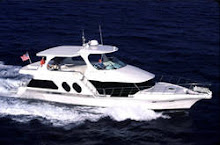How It All Began"Honey, it's not just a boat...it's a lifestyle!" That quote came from my husband the day he came home with what turned out to be the first of three boats we would own along our journey to becoming a liveaboard family.
I came face-to-face with my future "lifestyle" on a boat trailer hitched to the back of our truck. It was a 17'
SeaRay Sundancer bowrider.

It was cute, and my husband got it for a great price, but he had never owned a boat or done much boating.
Granted, we loved this little boat, drove it to every lake or ocean boat-ramp within hundreds of miles, but soon we outgrew it. It was during this
trial marriage, my spouse decided he wanted "more power" and off to the various boat shows we went in the pursuit of
power.
"Honey, it's not such a little a boat...this one really is a lifestyle!" That quote came from my husband the day he drove me to a marina about 80 miles from our home, stood me in front of another Sea Ray and grinned and pointed. Indeed, this boat was larger, it was a 30'
Sea Ray Sundancer with the outrageously arrogant name of "Bodacious".

We bought it He bought it, and soon my husband became the captain of
"more power." Now this boating thing was getting serious; by serious, I mean monthly payments, slip fees, and upkeep. Our new and bigger lifestyle could not sit on a trailer in the yard; this baby needed a slip
We soon learned an important lesson:secure a slip before you buy the boat. Thank goodness the boat brokerage that sold us the boat was able to keep the boat at their sales dock until we got a slip. We had known the size boat we wanted and the area we liked long before we bought, if we had just made sure there was a slip available, we would have saved a lot of time and worry.

We did manage to get a slip at a local hotel resort marina.
Now we were in the big-time of boat ownership. We had to find professionals to help us with day-to-day upkeep and rely on the marina dockmaster. Learning about the boat and how to operate her kept us busy for quite awhile.
In the beginning we loved having our boat at the hotel marina but this was only a temporary solution, although a good one, because we were only able to sublease the slip (via the dockmaster) from a boat owner who had his boat in Mexico for the winter and would return in a few months.
Again, we began the hunt for a boat slip. We put ourselves on every waiting list for a permanent slip and the waiting game began. The hotel marina was great, lots of sweet amenities and full use of all hotel facilities such as the pool, discounts at the restaurants and bars and lots of grassy areas for the dog. This was where we spent our weekends and holidays living on our new (yet previously owned) 30' floating condo. I learned how to cook on a miniature stove, how to sleep in a V-berth, and deal with little closet or storage space. And Loved it.
Our name finally cleared a waitlist and we were offered a permanent slip at a huge marina.  It took us about 30 minutes to pack up, stow stuff below deck, rev up the engines and cruise our floating condo to our new neighborhood. The new marina was wonderful, although quite large with over 500 slips; it too had a hotel and restaurants and tons of amenities. At this point, I think our dog Bandit was the most pleased with the move as this place boasted 11 acres of lush grounds and plenty of dog friendly space.
It took us about 30 minutes to pack up, stow stuff below deck, rev up the engines and cruise our floating condo to our new neighborhood. The new marina was wonderful, although quite large with over 500 slips; it too had a hotel and restaurants and tons of amenities. At this point, I think our dog Bandit was the most pleased with the move as this place boasted 11 acres of lush grounds and plenty of dog friendly space.
Our family loved coming to the boat for weekends during the year, and full weeks during the summer when school was out. We loved staying on the boat, and adapted to it so well an idea began to germinate: maybe we should think about getting a bigger boat and live on it. The game of "what if", became a part of our cruising weekends and over a period of several years, we were actually making plans to become liveaboards.
Slowly, we began learning how to actually become a liveaboard family and seeking information on the best type of boat for the three of us and our dog. My husband took every boating course he could find and, once again, we began attending boat shows. We sought advice from every liveaboard family we could find and questioned every boat broker around.
We finally settled on the perfect type of boat:
a Bluewater Motor Yacht and knowing a brand new boat was out of the question, we finally located a boat broker in San Francisco who bought and sold previous owned Bluewater boats. Knowing our search for the right size (we wanted 50' at least) at the right price (must be practically a give-away) would take a long time, we set our liveaboard plan in motion.
To become liveaboards, we could no longer live on our working horse ranch. We sold off our livestock, lined up a property management company as we would lease out our ranch, not sell it, until we knew for sure the liveaboard life was totally for us. At this point, my husband became so involved in the boating world that he decided not only to change our lifestyle, but to change his career as well.
He became a professional boat captain! Now that may be a bit of overkill for the average person who wants to liveaboard, but my husband went back to school and earned his
U.S. Coast Guard 100-ton Captain's license. He then lined up a part-time boat captain's job here in San Diego and worked weekends, while using our 30' boat as his base. We were nearly ready to go, all we now had to do was wait until we found the right boat and for our son to graduate middle school.
In the Winter of 2000 our broker found our boat, on a lake in Texas of all places, and off we flew to check it out. We loved it, the price was right (to this day it is still worth more that we originally paid), and at 60' it was much bigger than we ever hoped. 
The deal was made, our 30' Sea Ray sold and our new boat was trucked from Texas to a boat yard in San Diego.
Once the boat got new bottom paint and a few fixes at the boat yard, we motored it to our new, and bigger liveaboard slip in the same marina. This time we did plan ahead and made arrangements for the slip in advance of the purchase. Once you are actually in a marina and proven to be a good tenant, it is much easier to move your slip around and change your status to liveaboard.
In the Summer of 2001, with our ranch leased, our furniture in storage (where it still is to this day), our son signed up for high school in San Diego, and our Captain now working full-time, we officially moved aboard and have been enjoying our new "lifestyle" ever since.






















 We use this Dog Food Kit
We use this Dog Food Kit 





















